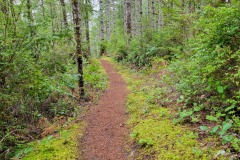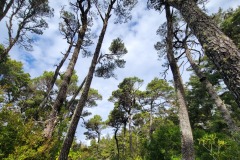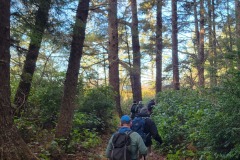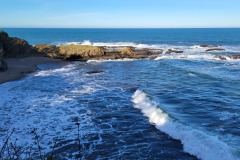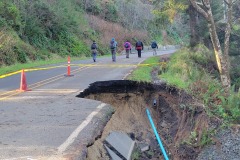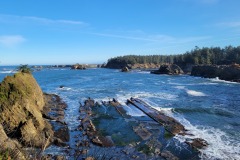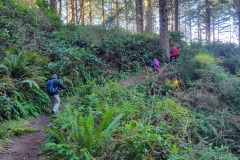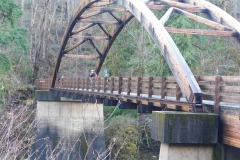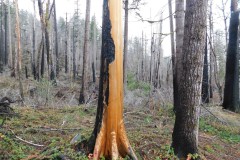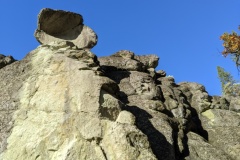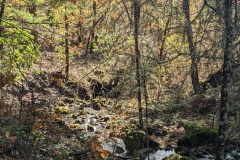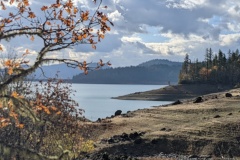Hike coordinator: Lane Harris
Narration by Lane Harris

Construction of the Buck Rock Tunnel began in August of 1883 and ended abruptly just 6 months later in February 1884 due to low funds. What was supposed to be a train tunnel was abandoned, leaving two caverns that await courageous hikers who dare brave their dark recesses. And, thanks to the suggestion of hiking pal Richard O’Neill, I decided to put this first-time destination for the club on the schedule.

The drive to Buck Rock is actually pretty straightforward. Why we have never hiked here before is kind of surprising, as its only 15 minutes off the freeway and the gravel roads are easily traveled. Maybe the fact that its south of Ashland and requires several hours in the car could have something to do with that.

With plenty of parking at the trailhead, the nine of us began the slow and steady climb up old access roads. Our first destination was Buck Rock at the top. Unless you are familiar with the roads here, a map is a necessity, as there are multiple intersections that can throw you off. And even that doesn’t guarantee a hiker from getting misplaced…

Even though I had prehiked this back in January, at some point after our first left turn to head uphill, I had gotten a bit off track. I somehow got pulled into one of those sucker trails that look like you’re on the right path, until it just dissipates into nothingness. No problem, as I consulted the oracle, otherwise known as my gps. I pulled up my track from January and discovered we were about 100 yards west from the road. We had two choices: backtrack and find the correct path or just bushwhack straight through the woods toward the road. Those who know me also know I enjoy off trailing every now and then. Bushwhack it is!

After relocating the quite obvious road, and wondering how the heck we coulda’ missed such a wide thing, we continued up the wooded hillside. I was concerned that the group’s faith in me as a hike leader may have been diminished somewhat after my little faux pas. But, like a ship’s crew considering mutiny against their captain, I also knew that they realized that if they wanted to return to their vehicles by the end of the day, that they would have no choice but to stick with the guy who had the route saved on his gps. And so, we sailed on.

The trail wound itself to the east, eventually leveled, and even dropped a little bit before slowly heading back uphill again. Now on the south side of the hill, we had a decent view to the south and the Siskiyou mountains. Soon, we reached the saddle between what is called Buck Rock North and Buck Rock South. After a short break, we once again, intentionally this time, went off trail towards Buck Rock North and its rocky ridgeline. The way to the top isn’t impossible, but it’s not easy either. Most of the group made it to the base of the rock, and only Terry and I made the final scramble to the very tippy top of Buck Rock.

What a view from the top! To the north we could see the southern Rogue Valley, with Emigrant Lake dominating the foreground. To the south we could easily make out Pilot Rock and the Siskiyous which still had snow on their peaks.

After a well-deserved lunch break, we picked our way down from Buck Rock and reconvened at the saddle. I had informed everyone earlier of the next leg of this journey, which was a downhill trek to a road which was, you guessed it, off trail. At least this one wasn’t a surprise. This short, quarter mile stroll through the trees cut off at least 2 miles of walking back the way we came. I believe this was my redemption for the unplanned mishap earlier, as everyone agreed fewer miles at this point was good thing!

Now on the north side of the hill, we eventually found the short trail that led us up to the west tunnel. We entered, but due to a large pool of water, we could only go about 30 feet in. Although they had not gotten terribly far on this side of the tunnel, maybe only 40 yards, it was still impressive to think of all the work that had to be done just to get this far. Comprised mostly of Chinese immigrants, workers only had dynamite and hand tools to dig into the side of the mountain. Imagine their disappointment (or joy) when someone rode up on horseback and said, “Fellas, we just ran out of money, pack it up!” And so, in the end, they eventually just caved. 🤣

We left the west tunnel and continued our journey around the south side of the mountain. The trail headed steadily uphill again, as I kept making promises and reassurances to Rheo that we were almost done with the altitude gain. At about the 5-mile mark, we rested again at another saddle before heading down again and towards the east tunnel.

The east tunnel is not marked at all, and you absolutely need to know where to go, or you just won’t ever find it. A short, indistinct path leads up a wooded draw and to the opening of the east tunnel. This is where the real fun begins! The tunnel goes back about 100 yards, considerably further than the west tunnel. Most of us donned our headlamps, flashlights or cellphones and proceeded into the dark depths. The ground was easy to walk on, and there was some water trickling through, but nothing that would prevent myself, Terry, Rheo and Amber from reaching the very back of the tunnel. We could see the boreholes that were made where the next explosives were to be placed for the next round of blasting. It was like seeing history put on pause for us to see what it was like for these miners back in 1883. Very cool.

After making our way out of the east tunnel and letting our eyes adjust to the bright outside light, we continued on down the trail, with the rest of the hike being fairly uneventful. We finished up this 8.5 miler fairly exhausted, but happy that we had visited this bit of Oregon history.

On a side note, I do have to mention that there were considerably more trees that had fallen across the trail than when I had visited here back in January. Regardless, and with annoyance, we managed to pick our way either over, under or around them. Just more reasons for my crew to mount a future mutiny against me.

Click on the video below to watch our fantastic journey into Buck Rock Tunnel!
Click here for extreme in-depth history and geology of Buck Rock Tunnel
The Buck Rock Tunnel Archaeological Site: Documenting Chinese Laborers and the Construction of the Oregon & California Railroad




















